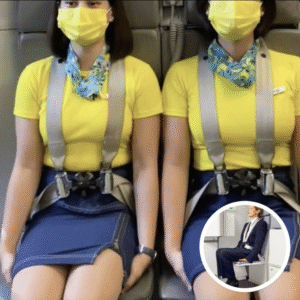Here’s why flight attendants sit on their hands during takeoff and landing—a small action that actually plays a critical role in aviation safety. Known in the industry as the “brace position,” this posture isn’t just a coincidence or habit. It’s a trained, deliberate technique designed to protect flight attendants during the most dangerous phases of flight.
Takeoff and landing are the two moments where the risk of incidents is statistically highest. During these times, flight attendants are often seated in jump seats, facing either the cabin or rear of the aircraft, with their seat belts and shoulder harnesses secured. You may have noticed that their hands are placed palms-up, usually under their thighs, with their feet flat on the floor and shoulder blades pressed against the seat. This specific position is meant to reduce injury if there’s a sudden impact or abrupt stop.
By sitting on their hands, flight attendants prevent their arms from flailing during a crash or hard landing, which could cause fractures or additional injury. Keeping the hands underneath the thighs secures them tightly and positions the body in a more compact, stable stance. This not only protects their limbs but also helps keep them conscious and alert, which is crucial in the seconds following an emergency when evacuations might be necessary.
Additionally, keeping the feet flat on the floor helps avoid leg injuries. In the event of a crash or hard braking, loose limbs can be tossed about violently. Bracing in this way ensures that the legs are grounded and less vulnerable to being broken or twisted. Pressing the head and back against the seat minimizes whiplash and spine injuries.
The practice has been fine-tuned over decades of aviation research and accident analysis. Investigations into past air incidents have shown that bracing positions like this can significantly reduce the likelihood and severity of injury. It’s part of the same safety training that instructs passengers to adopt the brace position during emergency landings—only tailored for the crew’s unique seating and responsibilities.
Beyond physical protection, there’s a psychological purpose as well. The routine of entering this brace position helps flight attendants mentally prepare for the possibility of impact. It’s a moment of silent readiness, allowing them to center their focus and be alert to the cabin’s status once the aircraft comes to a stop. They need to be able to unbuckle instantly, assess conditions, and begin guiding passengers to safety—every second matters.
Interestingly, the “hands-under-thighs” detail is not universally known by the public, but it’s widely practiced across airlines globally. It’s part of comprehensive emergency procedure training, and flight attendants are drilled in this technique repeatedly during their careers. Their job is not only about service—it’s primarily about safety, and this detail is a perfect example of that in action.
In some cases, passengers have mistaken this posture for nervousness or discomfort. In reality, it’s just the opposite. It’s a demonstration of training, composure, and preparedness. Flight attendants don’t brace out of fear—they do it out of discipline.
So next time you see a flight attendant seated during takeoff or landing, hands tucked neatly under their thighs, know that they are actively protecting themselves and preparing to protect you. It’s a silent, subtle sign of how much goes into making air travel safe—not just through technology and engineering, but through human readiness and professionalism.


